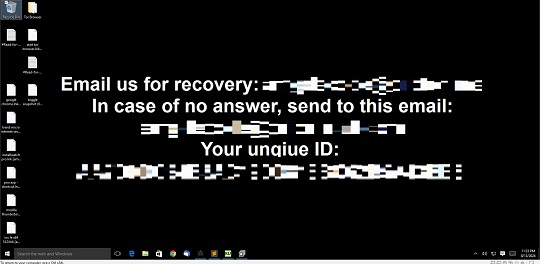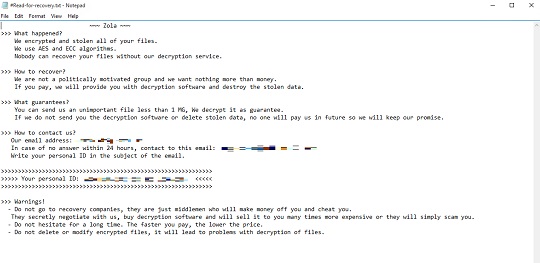Ransom.Win64.PROTOZOLA.A
Trojan-Ransom.Proton (IKARUS)
Windows


Threat Type: Ransomware
Destructiveness: No
Encrypted: No
In the wild: Yes
OVERVIEW
Downloaded from the Internet, Dropped by other malware
This Ransomware arrives on a system as a file dropped by other malware or as a file downloaded unknowingly by users when visiting malicious sites.
It drops files as ransom note. It avoids encrypting files with the following file extensions.
TECHNICAL DETAILS
1,058,304 bytes
EXE
Yes
06 Aug 2024
Disables AV, Displays graphics/image, Drops files, Encrypts files, Modifies system registry, Terminates processes
Arrival Details
This Ransomware arrives on a system as a file dropped by other malware or as a file downloaded unknowingly by users when visiting malicious sites.
Installation
This Ransomware adds the following processes:
- %System%\cmd.exe /c vssadmin Delete Shadows /all /quiet
- %System%\cmd.exe /c bcdedit /set {default} recoveryenabled No
- %System%\cmd.exe /c bcdedit /set {default} bootstatuspolicy ignoreallfailures
- %System%\cmd.exe /c wmic SHADOWCOPY /nointeractive
(Note: %System% is the Windows system folder, where it usually is C:\Windows\System32 on all Windows operating system versions.)
It adds the following mutexes to ensure that only one of its copies runs at any one time:
- 4B991369-7C7C-47AA-A81E-EF6ED1F5E24C
Autostart Technique
This Ransomware drops the following file(s) in the Startup Items folder to enable its automatic execution at every system startup:
- {victim ID}.exe → dropped copy
Other System Modifications
This Ransomware adds the following registry entries:
HKEY_CURRENT_USER\Software\Proton
public = {hex values}
HKEY_CURRENT_USER\Software\Proton
full = {hex values}
It sets the system's desktop wallpaper to the following image:
- %Program Data%\{victim ID}.bmp

Process Termination
This Ransomware terminates the following services if found on the affected system:
- wrapper
- DefWatch
- ccEvtMgr
- ccSetMgr
- SavRoam
- Sqlservr
- sqlagent
- sqladhlp
- Culserver
- RTVscan
- sqlbrowser
- SQLADHLP
- QBIDPService
- IntuitQuickBooksFCS
- QBCFMonitorService
- msmdsrv
- tomcat6
- zhudongfangyu
- vmware-usbarbitator64
- vmware-converter
- dbsrv12
- dbeng8
- MSSQL$MICROSOFT##WID
- MSSQL$VEEAMSQL2012
- SQLAgent$VEEAMSQL2012
- SQLBrowser
- SQLWriter
- FishbowlMySQL
- MSSQL$MICROSOFT##WID
- MySQL57
- MSSQL$KAV_CS_ADMIN_KIT
- MSSQLServerADHelper100
- SQLAgent$KAV_CS_ADMIN_KIT
- msftesql-Exchange
- MSSQL$MICROSOFT##SSEE
- MSSQL$SBSMONITORING
- MSSQL$SHAREPOINT
- MSSQLFDLauncher$SBSMONITORING
- MSSQLFDLauncher$SHAREPOINT
- SQLAgent$SBSMONITORING
- SQLAgent$SHAREPOINT
- QBFCService
- QBVSS
- YooBackup
- YooIT
- vss
- sql
- svc$
- MSSQL
- MSSQL$
- memtas
- mepocs
- sophos
- veeam
- backup
- bedbg
- PDVFSService
- BackupExecVSSProvider
- BackupExecAgentAccelerator
- BackupExecAgentBrowser
- BackupExecDiveciMediaService
- BackupExecJobEngine
- BackupExecManagementService
- BackupExecRPCService
- MVArmor
- MVarmor64
- stc_raw_agent
- VSNAPVSS
- VeeamTransportSvc
- VeeamDeploymentService
- VeeamNFSSvc
- AcronisAgent
- ARSM
- AcrSch2Svc
- CASAD2DWebSvc
- CAARCUpdateSvc
- WSBExchange
- MSExchange
- MSExchange$
It terminates the following processes if found running in the affected system's memory:
- wxServer
- wxServerView
- sqlmangr
- RAgui
- supervise
- Culture
- Defwatch
- winword
- QBW32
- QBDBMgr
- qbupdate
- axlbridge
- httpd
- fdlauncher
- MsDtSrvr
- java
- 360se
- 360doctor
- wdswfsafe
- fdhost
- GDscan
- ZhuDongFangYu
- QBDBMgrN
- mysqld
- AutodeskDesktopApp
- acwebbrowser
- Creative Cloud
- Adobe Desktop Service
- CoreSync
- Adobe CEF
- Helper
- node
- AdobeIPCBroker
- sync-taskbar
- sync-worker
- InputPersonalization
- AdobeCollabSync
- BrCtrlCntr
- BrCcUxSys
- SimplyConnectionManager
- SimplySystemTrayIcon
- fbguard
- fbserver
- ONENOTEM
- wsa_service
- koaly-exp-engine-service
- TeamViewer_Service
- TeamViewer
- tv_w32
- tv_x64
- TitanV
- Ssms
- notepad
- RdrCEF
- sam
- oracle
- ocssd
- dbsnmp
- synctime
- agntsvc
- isqlplussvc
- xfssvccon
- mydesktopservice
- ocautoupds
- encsvc
- tbirdconfig
- mydesktopqos
- ocomm
- dbeng50
- sqbcoreservice
- excel
- infopath
- msaccess
- mspub
- onenote
- outlook
- powerpnt
- steam
- thebat
- thunderbird
- visio
- wordpad
- bedbh
- vxmon
- benetns
- bengien
- pvlsvr
- beserver
- raw_agent_svc
- vsnapvss
- CagService
- DellSystemDetect
- EnterpriseClient
- ProcessHacker
- Procexp64
- Procexp
- GlassWire
- GWCtlSrv
- WireShark
- dumpcap
- j0gnjko1
- Autoruns
- Autoruns64
- Autoruns64a
- Autorunsc
- Autorunsc64
- Autorunsc64a
- Sysmon
- Sysmon64
- procexp64a
- procmon
- procmon64
- procmon64a
- ADExplorer
- ADExplorer64
- ADExplorer64a
- tcpview
- tcpview64
- tcpview64a
- avz
- tdsskiller
- RaccineElevatedCfg
- RaccineSettings
- Raccine_x86
- Raccine
- Sqlservr
- RTVscan
- sqlbrowser
- tomcat6
- QBIDPService
- notepad++
- SystemExplorer
- SystemExplorerService
- SystemExplorerService64
- Totalcmd
- Totalcmd64
- VeeamDeploymentSvc
Other Details
This Ransomware does the following:
- It empties the Recycle Bin.
- It terminates itself if the keyboard layout is the following:
- Persian
Ransomware Routine
This Ransomware avoids encrypting files with the following strings in their file name:
- ntldr
- ntuser.dat.log
- bootsect.bak
- autorun.inf
- thumbs.db
- iconcache.db
- #read-for-recovery.txt
It avoids encrypting files found in the following folders:
- intel
- msocache
- $recycle.bin
- system volume information
- $windows.~bt
- $windows.~ws
- boot
- windows nt
- msbuild
- all users
- microsoft
- common files
It appends the following extension to the file name of the encrypted files:
- {original filename}.{original extension}.amgdecode@proton.me.Zola
It drops the following file(s) as ransom note:
- %Desktop%\#Read-for-recovery.txt
- {encrypted directory}\#Read-for-recovery.txt

It avoids encrypting files with the following file extensions:
- .exe
- .dll
- .msi
- .bmp
- .ico
- .zola
SOLUTION
9.800
19.528.04
14 Aug 2024
19.529.00
15 Aug 2024
Step 1
Trend Micro Predictive Machine Learning detects and blocks malware at the first sign of its existence, before it executes on your system. When enabled, your Trend Micro product detects this malware under the following machine learning name:
- Troj.Win32.TRX.XXPE50FFF083
Step 2
Before doing any scans, Windows 7, Windows 8, Windows 8.1, and Windows 10 users must disable System Restore to allow full scanning of their computers.
Step 3
Note that not all files, folders, and registry keys and entries are installed on your computer during this malware's/spyware's/grayware's execution. This may be due to incomplete installation or other operating system conditions. If you do not find the same files/folders/registry information, please proceed to the next step.
Step 4
Delete this registry key
Important: Editing the Windows Registry incorrectly can lead to irreversible system malfunction. Please do this step only if you know how or you can ask assistance from your system administrator. Else, check this Microsoft article first before modifying your computer's registry.
- In HKEY_CURRENT_USER\Software\Proton
Step 5
Search and delete these files
- %Desktop%\#Read-for-recovery.txt
- {encrypted directory}\#Read-for-recovery.txt
- %Program Data%\{victim ID}.bmp
- %Common Startup%\{victim ID}.exe
Step 6
Reset your Desktop properties
Step 7
Scan your computer with your Trend Micro product to delete files detected as Ransom.Win64.PROTOZOLA.A. If the detected files have already been cleaned, deleted, or quarantined by your Trend Micro product, no further step is required. You may opt to simply delete the quarantined files. Please check the following Trend Micro Support pages for more information:
Step 8
Restore encrypted files from backup.
Did this description help? Tell us how we did.

